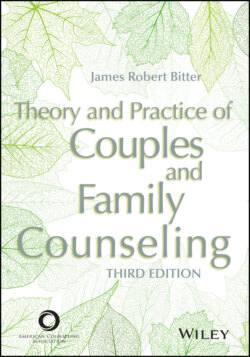Читать книгу Theory and Practice of Couples and Family Counseling - James Robert Bitter - Страница 115
INTRODUCTION TO THE CASE OF THE QUEST FAMILY
ОглавлениеOne of the best ways to learn about a theory is to see it in action. Viewing a live demonstration is often the best way to make initial observations about the therapeutic process with families. There are also many useful videotapes and DVDs that allow you to sit in with master therapists at work.1
I have attempted to give you some of the same kind of demonstration experience through the creation of the Quest family. Toward the end of each theory chapter, I present the Quest family case as if they were seeing a counselor who uses that chapter’s approach. Each example includes dialogue that I hope will give you another opportunity to experience the model in action.
When you read about each theory and practice as it is applied to the Quest family (and to the case presented toward the beginning of each chapter), you might want to ask yourself several questions:
What kind of relationship does the counselor form with the family, and what skills are used to establish that relationship?
What sequences or patterns do you notice both in the descriptions of how the family interacts at home and within the sessions themselves?
How is the family organization affecting their ability to cope with life and handle the challenges they face?
How do family members communicate with one another, and how do their communications reflect family roles and rules?
Where is the family in terms of both individual and family life cycle development? That is, are individual adults facing the world on their own; coupling; forming a family with young children; adjusting to family life with adolescents; launching young adults; coping with divorce, remarriage, or blending families; or handling issues related to aging, later life, and death? Each of these normal developmental experiences tends to cause stress and challenge the family’s resources. How well is the family coping with change?
What parts of each individual are used or ignored in the way people cope? Given the family dynamics, what purpose might individuals have for behaving and interacting the way they do?
How do cultural and gender issues affect your understanding of the family, its members, and the ways in which the practitioner intervenes in family process?
What goals are established for counseling, and which skills, techniques, and interventions are used in the service of those goals?
How would you proceed if you were working with the Quest family within the various models presented?
How would you evaluate the process and success of your therapeutic interventions?
These questions invite you to think about the Quest family and other demonstrations of the models from many different perspectives. Each perspective is like a different pair of glasses with different sets of lenses. What do you see if you actively choose to look at the family differently? Of course, no amount of thinking about a family or even watching the masters at work can substitute for actual practice under supervision. If you are not already engaged in seeing families, that will happen soon. During this first exploratory stage, however, I urge you to let your mind and heart become engaged with the ideas and processes of family counseling. Imagination can be the start of actualization: Visualizing yourself in action is great preparation for your first counseling sessions with families.
Examining the various approaches to working with the Quest family will allow you to compare and contrast different stances in relation to family practice. It will also give you a chance to decide which aspects of family practice fit for you and which parts seem foreign or unacceptable to you. I would urge you to continually consider how you might plan to integrate the approaches you like into a coherent whole.
Below I present the story of the Quest family, which is constant for all couples and family counseling models in this book. When you finish reading about the Quest family, ask yourself whether you think the family is functional or dysfunctional, healthy or unhealthy, in need of minor adjustment or a major restructuring. What do the answers to these questions say about your initial approach to and contact with the family? Then allow yourself to ask different kinds of questions: What are you curious about? What do you want to know next? What metaphor comes to your mind about providing counseling for this family? Do the considerations of curiosity and metaphor lead to different perspectives than the questions about functionality? Welcome to the journey.
